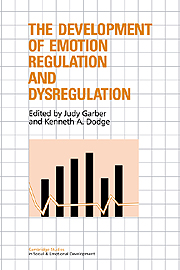Book contents
- Frontmatter
- Contents
- List of contributors
- Preface
- Part I Introduction
- Part II Early development
- 2 Contributions from the study of high-risk populations to understanding the development of emotion regulation
- 3 Development of emotion expression during infancy: General course and patterns of individual difference
- 4 Infant social referencing
- 5 Relationships, talk about feelings, and the development of affect regulation in early childhood
- Part III Physiological regulation
- Part IV Cognitive regulation
- Part V Psychopathology
- Part VI Integration
- Author index
- Subject index
2 - Contributions from the study of high-risk populations to understanding the development of emotion regulation
Published online by Cambridge University Press: 26 March 2010
- Frontmatter
- Contents
- List of contributors
- Preface
- Part I Introduction
- Part II Early development
- 2 Contributions from the study of high-risk populations to understanding the development of emotion regulation
- 3 Development of emotion expression during infancy: General course and patterns of individual difference
- 4 Infant social referencing
- 5 Relationships, talk about feelings, and the development of affect regulation in early childhood
- Part III Physiological regulation
- Part IV Cognitive regulation
- Part V Psychopathology
- Part VI Integration
- Author index
- Subject index
Summary
In this chapter we shall examine the processes of emotion regulation and dysregulation. We define emotion regulation as the intra- and extraorganismic factors by which emotional arousal is redirected, controlled, modulated, and modified to enable an individual to function adaptively in emotionally arousing situations. Emotion regulation helps maintain internal arousal within a manageable, performance-optimizing range. Whereas the emotions mediate a person's adaptive functioning by providing crucial information to the self and others about internal states, emotion regulatory systems are essential to the individual in order to maintain a tolerable but flexible range of affective expressions necessary for adaptive functioning across the life span. Feedback components of the emotion system also serve a critical role in the development of self-evaluation and selfregulation (Cicchetti & Schneider-Rosen, 1986; Izard, 1977).
The guiding theoretical orientation of our study of emotion regulation is based on principles derived from the organizational perspective on development (Cicchetti, 1990; Cicchetti & Aber, 1986; Cicchetti & Sroufe, 1978; Sroufe & Waters, 1976). According to this perspective, development is conceived as a series of qualitative reorganizations among and within behavioral and biological systems. Through the processes of differentiation and hierarchical integration, individuals move from a relatively diffuse, undifferentiated condition to a state of increasingly differential and hierarchically organized behavioral complexity (Werner, 1957). During this process, intrinsic or organismic factors and extrinsic, environmental factors dynamically interact to determine a person's developmental outcome on a number of unfolding stage-salient issues (Cicchetti, 1990).
- Type
- Chapter
- Information
- The Development of Emotion Regulation and Dysregulation , pp. 15 - 48Publisher: Cambridge University PressPrint publication year: 1991
- 156
- Cited by



